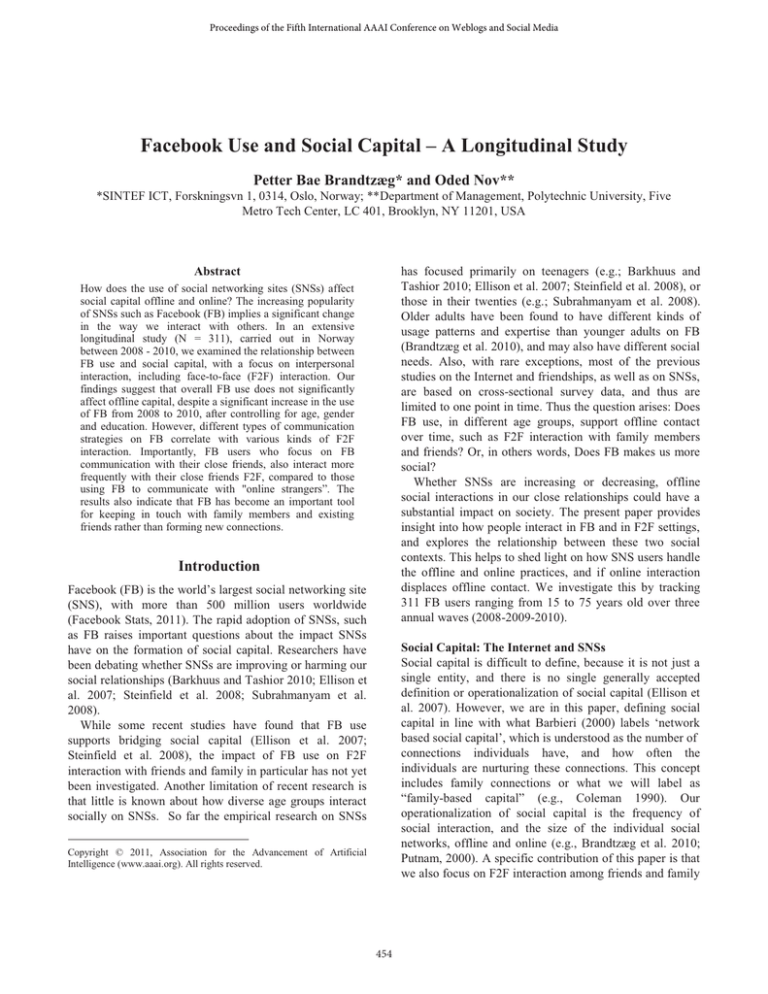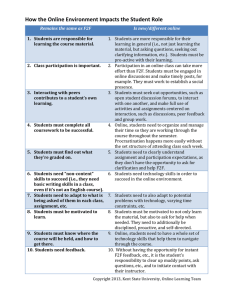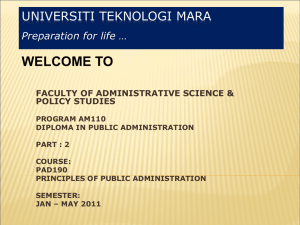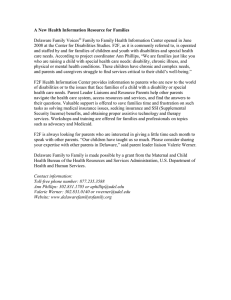
Proceedings of the Fifth International AAAI Conference on Weblogs and Social Media
Facebook Use and Social Capital – A Longitudinal Study
Petter Bae Brandtzæg* and Oded Nov**
*SINTEF ICT, Forskningsvn 1, 0314, Oslo, Norway; **Department of Management, Polytechnic University, Five
Metro Tech Center, LC 401, Brooklyn, NY 11201, USA
has focused primarily on teenagers (e.g.; Barkhuus and
Tashior 2010; Ellison et al. 2007; Steinfield et al. 2008), or
those in their twenties (e.g.; Subrahmanyam et al. 2008).
Older adults have been found to have different kinds of
usage patterns and expertise than younger adults on FB
(Brandtzæg et al. 2010), and may also have different social
needs. Also, with rare exceptions, most of the previous
studies on the Internet and friendships, as well as on SNSs,
are based on cross-sectional survey data, and thus are
limited to one point in time. Thus the question arises: Does
FB use, in different age groups, support offline contact
over time, such as F2F interaction with family members
and friends? Or, in others words, Does FB makes us more
social?
Whether SNSs are increasing or decreasing, offline
social interactions in our close relationships could have a
substantial impact on society. The present paper provides
insight into how people interact in FB and in F2F settings,
and explores the relationship between these two social
contexts. This helps to shed light on how SNS users handle
the offline and online practices, and if online interaction
displaces offline contact. We investigate this by tracking
311 FB users ranging from 15 to 75 years old over three
annual waves (2008-2009-2010).
Abstract
How does the use of social networking sites (SNSs) affect
social capital offline and online? The increasing popularity
of SNSs such as Facebook (FB) implies a significant change
in the way we interact with others. In an extensive
longitudinal study (N = 311), carried out in Norway
between 2008 - 2010, we examined the relationship between
FB use and social capital, with a focus on interpersonal
interaction, including face-to-face (F2F) interaction. Our
findings suggest that overall FB use does not significantly
affect offline capital, despite a significant increase in the use
of FB from 2008 to 2010, after controlling for age, gender
and education. However, different types of communication
strategies on FB correlate with various kinds of F2F
interaction. Importantly, FB users who focus on FB
communication with their close friends, also interact more
frequently with their close friends F2F, compared to those
using FB to communicate with "online strangers”. The
results also indicate that FB has become an important tool
for keeping in touch with family members and existing
friends rather than forming new connections.
Introduction
Facebook (FB) is the world’s largest social networking site
(SNS), with more than 500 million users worldwide
(Facebook Stats, 2011). The rapid adoption of SNSs, such
as FB raises important questions about the impact SNSs
have on the formation of social capital. Researchers have
been debating whether SNSs are improving or harming our
social relationships (Barkhuus and Tashior 2010; Ellison et
al. 2007; Steinfield et al. 2008; Subrahmanyam et al.
2008).
While some recent studies have found that FB use
supports bridging social capital (Ellison et al. 2007;
Steinfield et al. 2008), the impact of FB use on F2F
interaction with friends and family in particular has not yet
been investigated. Another limitation of recent research is
that little is known about how diverse age groups interact
socially on SNSs. So far the empirical research on SNSs
Social Capital: The Internet and SNSs
Social capital is difficult to define, because it is not just a
single entity, and there is no single generally accepted
definition or operationalization of social capital (Ellison et
al. 2007). However, we are in this paper, defining social
capital in line with what Barbieri (2000) labels ‘network
based social capital’, which is understood as the number of
connections individuals have, and how often the
individuals are nurturing these connections. This concept
includes family connections or what we will label as
“family-based capital” (e.g., Coleman 1990). Our
operationalization of social capital is the frequency of
social interaction, and the size of the individual social
networks, offline and online (e.g., Brandtzæg et al. 2010;
Putnam, 2000). A specific contribution of this paper is that
we also focus on F2F interaction among friends and family
Copyright © 2011, Association for the Advancement of Artificial
Intelligence (www.aaai.org). All rights reserved.
454
members. In addition, we distinguish between different
types of social capital - bonding and bridging capital.
According to Ellison et al. (2007), bridging capital is
associated with weak ties (acquaintances), and bonding
capital with strong ties (family and close friends).
However, it should be noted, that we only map the social
network and the association between offline and online
contact - not the consequences of social capital as a social
resource or value.
sample of FB users from Norway aged 15 to 75 years, in
2008, 2009 and 2010. Descriptive statistics of the sample
are shown in Table 1. Method description is fully presented
in Brandtzæg and Lüders, 2008)
Year
2008
2009
2010
Sample size
N = 311
N = 311
N=311
32%
37%
19%
8%
5%
32%
37%
18%
8%
5%
32%
37%
17%
9%
6%
39%
61%
39%
61%
39%
61%
4%
29%
66%
1%
33%
4%
29%
66%
1%
32%
4%
29%
66%
1%
31%
Age
15-30
31-40
41-49
51-60
61-75
Gender
Male
Female
Education
Compulsory
High school
University
Other
Students
Research Hypotheses
The majority of previous research has uncovered a positive
correlation between electronic communication such as
SNSs, and F2F interaction, as well as different types of
social capital formation (e.g. Ellison et al., 2007). Based on
this prior work we propose the following hypotheses:
Family-based capital, offline and online: New reports
show that family members and older adults increasingly
visit SNSs such as FB (Ellison et al. 2009; Facebook
statistics 2011), which might make it easier for family
members to stay connected online and offline:
• H1a: The use of FB will be positively associated with
users’ F2F interaction with family.
• H1b: The use of FB will be positively associated with
users’ online FB interaction with family members.
Table 1. Sample characteristics (in %)
Measures
In addition to demographics (Table 1), the questionnaire
included the following measures:
Offline interaction: We used two questions to measure
the frequency of F2F interaction with 1) Family, and 2)
Close friends using a 6-point response scale: 1-Never; 2Rarely; 3-Several times a year; 4-Several times a month; 5Several times a week; 6-Daily. Offline social networks:
Two questions: (i) How many close friends do you have?
Using a 7-point scale: 1 (None), 2 (1-2), 3 (3-5), 4 (6-8), 5
(9-11), 6 (12-15), 7 (More than 15). (ii) In total, how many
friends and acquaintance do you have? Using a 10-point
scale; 1 (Fewer than five), 2 (6-10), 3 (11-20), 4 (21-30), 5
(31-50), 6 (51-100), 7 (101- 200), 8 (201- 500), 9 (501 –
1000), 10 (More than 1000). Online- interaction on FB:
We asked the following four questions: “With usage of FB,
how often do you have contact with the following
persons?” 1) Close friends, 2) Acquaintances, 3) Family
members you do not live with, and 4) People you only
have met online. We used the same 6-point scale as for
offline interaction. Online-social networks on FB: We
asked questions about (1) the number of acquaintance’s on
FB (similar 10-point scale as offline), (2) the number of
close friends on FB (similar 7-point scale as offline), and
(3) the number of family members on FB (5-point scale).
Overall use of FB: “How often do you visit Facebook?”
With answers ranging between: 1-Never or almost never,
2-Several times a month, 3- Several times a week, and 4daily.
Prior research (e.g., Barkhuus and Tashiro 2010; Ellison et
al. 2007) suggests that the Internet can enhance F2F
interaction, and that FB is mainly a tool to keep up with
existing offline relationships, rather than to initiate new
online. Our next hypotheses are therefore:
• H2a: The use of FB will be positively associated with an
increase in users’ F2F interaction with close friends.
• H2b: The use of FB will be positively associated with an
increase in the number of users’ close friends’ offline.
• H2c: The use of FB will be positively associated with an
increase in the number of users’ close friends’ online.
Bridging capital, offline and online: Previous research
shows that the use of SNSs and FB is positively associated
with bridging social capital (Ellison et al. 2007; Steinfield
2008), therefore:
• H3a: The use of FB will be positively associated with
users’ number of offline friends and acquaintances
(bridging capital).
• H3b: The use of FB will be positively associated with the
number of acquaintances (bridging capital), and the
frequency of contact with acquaintances and “people you
only have met online”.
Method
This research uses longitudinal data. The data was
collected using an online questionnaire filled out by a
455
Analysis and results
Our numbers in Figure 1 suggest that FB, from 2008 to
2010, has become significantly more popular. In 2010, the
majority, in all age groups use FB on a daily basis.
The correlation results are presented in Table 3. We also
checked how the correlation coefficients were different
from 2008 to 2010.
We assess how FB usage influences social capital offline
and online. We used Partial correlations (r) controlling for
age, gender, and education. We did this in the three time
periods, to study the developmental trends from 2008 to
2010. We also tested the statistical significance of the
differences between the correlation coefficients over time,
using the Fisher r-to-Z transformation.
Descriptive statistics for all our social capital measures
are available in Table 2. An inspection of the mean scores
does not show any essential changes among offline
variables from 2008 to 2010.
Offline variables
F2F interaction with
family
F2F interaction with
close friends
Number of
acquaintances
Number of close
friends
Online variables
FB-use frequency
Nr. of acquaintances
on FB
Family friends on
FB
Number of close
friends on FB
Family interaction
on FB
Interaction with
acquaintances on FB
Interaction with
close friends on FB
Interaction with
“online strangers”
2008
M
SD
2009
M
SD
3.87
0.86
3.90
0.89
3.95
0.89
4.65
0.95
4.62
0.94
4.58
0.94
5.43
1.93
5.50
1.91
5.65
2.04
3.50
1.37
3.56
1.20
3.67
1.36
3.28
5.65
0.81
2.09
3.51
6.51
0.73
1.80
3.67
7.11
0.62
1.49
2.29
0.79
2.76
0.96
3.04
1.02
3.45
1.52
3.70
1.52
3.89
1.54
2.18
1.22
2.45
1.30
2.70
1.34
3.35
1.36
3.49
1.34
3.67
1.26
3.33
1.42
3.51
1.39
3.72
1.38
1.75
1.33
1.62
1.20
1.71
1.29
Offline variables
F2F interaction with
family
F2F interaction with
close friends
Number of
acquaintances
Number of close friends
Online variables
Number of
acquaintances on FB
Number of family
friends on FB
Number of close friends
on FB
Family interaction on FB
Interaction with
acquaintances on FB
Interaction with close
friends on FB
Interaction with “online
strangers”
2010
M
SD
Use of
FB 2008
Use of
FB 2009
Use of
FB 2010
-.030
-.004
- .067
+ .044
+.062
+ .101
+ .118**
+. 064
+.045
+ .070
+ .040
- .020
+.413**
+.352**
+.203**
+ .193**
+ .304**
+.157**
+.158**
+.223**
+.100
+.274**
+.397**
+.265**
+.351**
+.229**
+.420**
+.215**
+.412**
+.397**
+.063
+.159**
+.097
Table 3. Partial correlations (r) between the overall use of FB
with offline and online variables (2008-2009-2010), (N=311).
Notes: Correlation is significant at the 0.05 level ** (2-tailed).
Family-Based Capital: H1a and H1b
H1a: Partly supported. No significant correlation between
family interaction, and overall FB usage (see Table 3).
H1b: Supported. FB use is significantly and positively
correlated with family interaction online in FB.
Bonding Capital: H2a, H2b and H2c
H2a: Partly supported. FB-use is positively associated with
individuals’ F2F interaction with friends over time, but not
significantly (see Table 3). However, in Table 4, when we
investigate the use of FB as a communication channel with
friends, we see a significant positive correlation, however,
the trend shows that this declined from 2008 to 2010, p =
0.403.
H2b: Not supported. We find no significant correlation
between the use of FB and the number of close offline
friends. The trend is somewhat negative from 2008 (r)2010 (r), but not significant.
H2c: Supported. Online bonding capital in FB, among
close friends, is positive and significantly (see Table 3).
Table 2. Summary of Mean (M) and Standard Deviation (SD) for
variables used in the study (N= 311).
Figure 1. Daily FB users in the population in % by age (N = 311)
from 2008 to 2009
456
F2F/offline variables
F2F interaction family
F2F interaction with
close friends
2009) explains the increasingly important role of FB in
facilitating family interactions.
A third contribution of this study is that our findings, in
general, contradict the assumption of the social
displacement effect (e.g., Kraut et al. 1998), that time spent
on social media will displace other and more apparent
offline social activities such as F2F interaction.
Fourth, the findings support the bridging capital
hypothesis online but not necessarily offline.
Finally, this study has limitations. The study was
conducted in a specific SNS, namely FB, and in one
country, Norway. While there is a strong rationale for these
choices (FB is the largest SNS, and Norwegians are early
adopters of technologies in general; SNSs in particular)
studies of other SNS, possibly in other countries, could
enhance the generalizability of our findings.
2008
2009
2010
Interaction with close friends on FB
+.070
+.093
-.044
+.219**
+.142**
+.154**
Family interaction on FB
F2F interaction with
family
F2F interaction with
close friends
F2F interaction with
family
F2F interaction with
close friends
+.150**
+.029
+.204**
-.011
+.135**
+.067
Interaction with “online strangers”
on FB
-0.13
+.037
+.026
-.063
+.008
+.033
Table 4. Partial correlations (r) between types of F2F interaction
different communication strategies (2008-2009-2010), (N=311).
Notes: Correlation is significant at the 0.05 level ** (2-tailed).
References
Barbieri, P. with Paugam, S. and Russell, H. 2000. ‘Social capital
and exits from unemployment’. In D. Gallie and S. Paugam. eds.
Welfare Regimes and the Experience of Unemployment in
Europe. Oxford: Oxford University Press: 200-217.
Barkhuus, L., and Tashiro, J. 2010. Student Socialization in the
Age of Facebook. In Proceedings of CHI, 133-142. ACM Press.
Brandtzæg, P.B., Lüders, M., and Skjetne, J. H. 2010. Too Many
Facebook “friends”? Content Sharing and Sociability Versus the
Need for Privacy in Social Network Sites. International Journal
of Human-Computer Interaction 26, 11: 123–138.
Brandtzæg, P. B., and Lüders, M. 2009. Privacy 2.0: Privacy and
Consumer Issues in the New Media Reality, SINTEF report on
behalf of the Consumer Council, Oslo, Norway.
Coleman, J. 1990. Foundations of social theory. Cambridge, MA:
Harvard University Press.
Ellison, N. B., Lampe, C., and Steinfield, C. 2009. Social network
sites and society: Current trends and future possibilities.
Interactions 16, 1: 6–9.
Ellison, N. B., Steinfield, C., and Lampe, C. 2007. The benefits of
Facebook “friends”: Social Capital and College Students' Use of
Online Social Network Sites. Journal of Computer-Mediated
Communication 12, 4: 1143–1168.
Facebook. 2011. Facebook statistics . Retrieved from
http://www.facebook.com/press/info.php?statistics.
Kraut, R. E., et al. 1998. Internet paradox: A social technology
that reduces social involvement and psychological well-being?
American Psychologist 53, 9: 1017-1032.
Putnam, R. D. 2000. Bowling alone. The collapse and revival of
American community. New York: Simon and Schuster.
Steinfield, C., Ellison, N. and Lampe, C. 2008. Social capital,
self-esteem, and use of online social network sites: A longitudinal
analysis. Journal of Applied Developmental Psychology 29, 6:
434-445.
Subrahmanyam, K., Reich, S., Waechter, N., and Espinoza, G.
2008. Online and offline social networks: Use of social
networking sites by emerging adults. Journal of Applied
Developmental Psychology 29: 420−433.
Bridging Capital: H3a and H3b
H3a: Not supported. There is a significant correlation
between the use of FB and a wider circle of friends and
acquaintances offline in 2008, but not in 2009 and 2010.
H3b: Supported. There is a significant correlation
between the use of FB, and a having a wider circle of
friends and acquaintances on FB, as well as a frequency of
contact with them. However, this trend declined over the
years (with a significant difference between the correlation
coefficients in 2008 and 2010, p = 0.003). “Interaction with
people I don’t know” is not significant (except in 2009).
Discussion and conclusions
The results reveal a rapid growth of FB-usage from 2008 to
2010 among all age groups, which implies a substantial
change to our traditional ways of interacting with others.
FB has become commonplace and a well integrated
communication tool to keep up with friends and family.
Further, this study makes a number of contributions: First,
we found that F2F interaction with close friends is
positively related to FB communication with close friends
in all three waves. In addition, we also found that FB
communication with family members is associated with
F2F communication with family members (see Table 4).
This might imply that different communication behavior
on FB supports certain kinds of F2F interaction. FB use
can, therefore, have a reciprocal effect on F2F interaction
with strong ties.
A second contribution is the identification of the
increasing presence of family members on FB; both in
terms of number of family members who are FB friends,
and the frequency of interaction (see Table 3). A growing
age diversity of the user population on SNSs (Ellison et al.,
457




